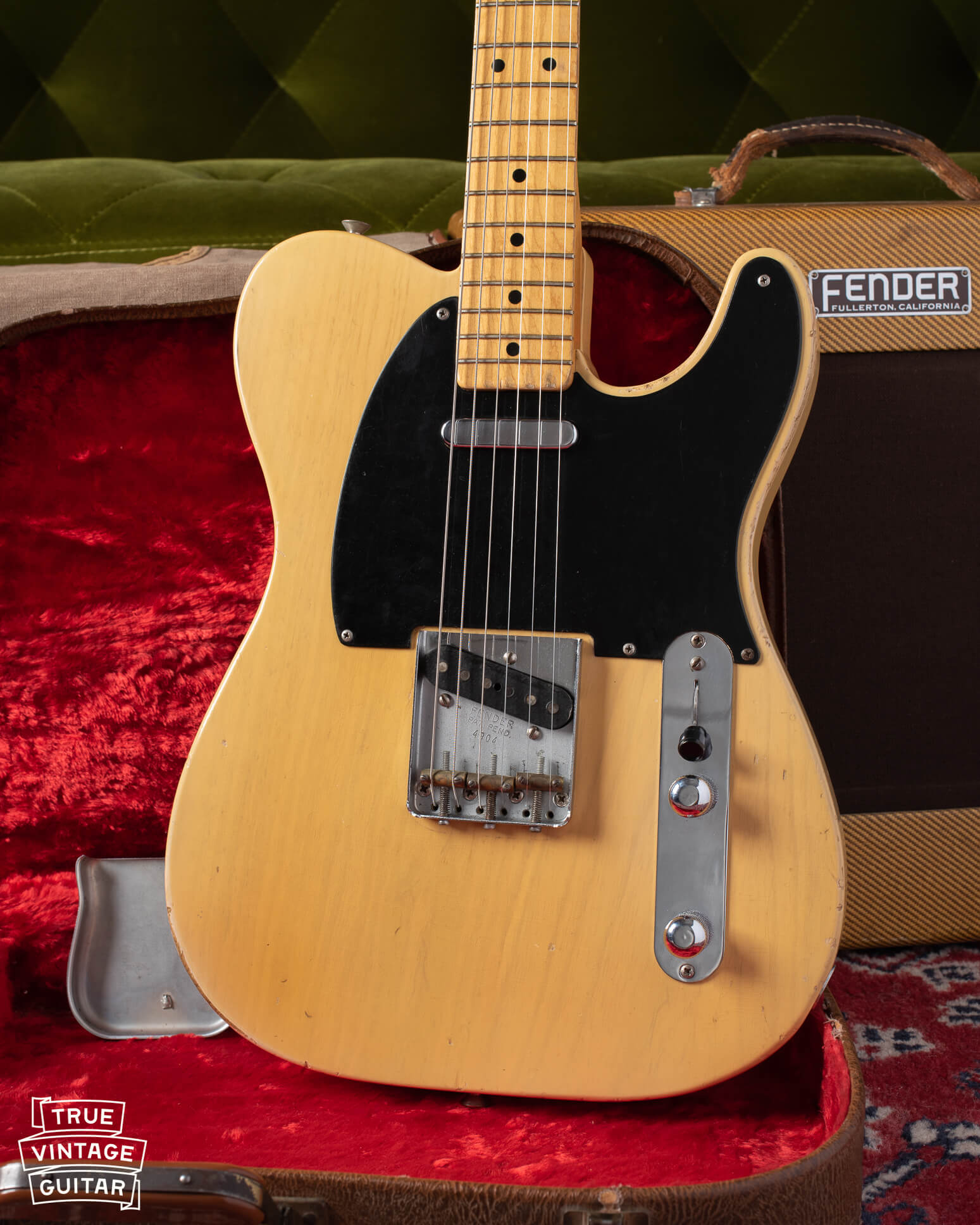I am so excited to share with you what may be the rarest Fender custom color ever: this 1960 Fender Jazzmaster in original Violet! This is a previously unknown Fender custom color which pre-dates the official debut of Fender’s own custom color chart from the summer of 1961. I received pictures of this purple Jazzmaster over three and a half years ago and I've dreamed about having it in hand since then. When I finally arrived at the previous owner's house last week and saw it for the first time, it was every bit as stunning as it looked in the first picture. My fellow guitar collectors know that the feminine pastel custom colors are the rarest — and to this collector, the most desirable — of them all.

Short History Of Fender Custom Colors
There is a lot of crossover from car culture to guitar culture, but one major difference between old cars and old guitars is that Fender guitars were offered primarily in a standard color. The Jazzmaster was introduced in 1958 in a striking Sunburst finish, but if you read the price list carefully, you'll see a little footnote at the bottom of Spanish-style electric guitar section: "Available in custom DuPont Ducco finishes - 5% additional cost". The price list misspelled "Duco" as "Ducco", but at any rate, most players quite liked the Sunburst finish. The vast majority were not keen to pay the 5% additional cost for the custom color, so the vast majority of the Jazzmasters in existence are finished in Sunburst.
Some players, however, did opt for the custom color finish and were willing to pay the additional cost. Since there was no official Fender color chart yet, people either asked for a certain DuPont Duco color from a color chart offered by a car company, or simply asked for the color they wanted and let the folks at Fender choose for them. Popular colors included Reds such as Roman Red or Seminole Red (predating Fender's Dakota or Fiesta Reds), Black, White, Blonde, Green, or Blue. Some colors proved to be very unpopular like Shell Pink - a color that appeared on the first chart in 1961 but was supplanted by the ever popular Candy Apple Red Metallic in the next edition of the chart in 1963. One such color that I had truly never seen or even heard of until this guitar: Violet.
There is little research in print or online about these pre-color chart custom colors from Fender. Most of the information that I've been able to gather comes from personal experience with some pretty exceptional examples including this 1959 Fender Stratocaster Roman Red and this 1960 Fender Jazzmaster Black with Gold Hardware. As a person obsessed with vintage Fender guitars, I end up looking at as many custom color Fenders online as I can. I have truly never seen another example of an original Fender applied custom color pastel purple guitar ever. The closest I've ever seen is some metallic purples that Fender used on some Telecasters in the late 1960s and early 1970s.
You can read more information on Fender's custom colors here: Story of Fender Custom Colors at Guitarplayer.com by Dave Hunter.

Story of this 1960 Fender Jazzmaster Violet
As a vintage guitar dealer, I'm always looking to buy the nicest examples of vintage Fender guitars (Sell a vintage Fender here). In the Spring of 2022, I received an email from someone that included a picture of what appeared to be a pastel purple Fender Jazzmaster made in 1960. I responded quickly to say that this is either a very special original Fender custom color, or it's one of the many unfortunate Fenders which were stripped of their original finish in favor of something else. I mentioned that the purple color was extremely cool either way, and that I would very much like to inspect it in person. I received one tepid response; I never heard from them again after that. The saved picture on my phone always delighted me when I stumbled upon it in my photos. I tried emailing them many times. There was no name attached to the email, so I kept hitting dead ends.
It never sat right with me. Could this be real? If so, why won't they respond? I couldn't let it go, and I'm glad I didn't. I set out again to look for information three and a half years later and got very lucky to find a new bit of contact information. I received a call from the owner a few days later. They were very surprised that I had a picture of it and were willing to tell the story.
A young man was privileged to have a godfather who was a retired touring musician in the 1960s. The young man graduated high school in 1982; the godfather felt obligated to give a gift. Can you image the young man's surprise when he opened the case to find a pastel purple Fender Jazzmaster?! This must have been the least cool guitar ever in 1982. If many more were made in this color, the vast majority must have been sanded down and refinished. I explained to the owner on the phone why my interest was so piqued about this guitar. So few feminine colors like purple and pink were made; most were refinished later to a more popular color.

1960 Fender Jazzmaster Violet Authentication
My gut instinct told me that this guitar was real, but I knew that the real authentication had to be done with an in person inspection under the pickguard. I'm so lucky to have personally owned and inspected a few different pre-color chart custom color Fenders and have saved all the pictures on my hard drive for future use. It's one thing to say what a real original finish should look like- but it's another to prove it with examples from the same time period. With a custom color finish as rare (or unheard of) as this, the authentication couldn't be more important. If you have a rare Fender custom color guitar and are looking for help with authentication and value, contact me here: Vintage Guitar Appraisal.





Another clue about the production of this guitar is the control cavity shape and the extra screws in the pickguard. When the Jazzmaster was introduced in 1958, Fender used a gold anodized aluminum sheet for the pickguard (1958 Fender Jazzmaster). The three layer nitrate (tortoise shell or mint green for custom colors) guard was introduced in the 1959, but Fender noticed a problem soon after. The nitrate material was prone to shrinking, so they added an extra shelf of wood in the control cavity route so that two extra screws could be used. This early 1960 Jazzmaster had a gold guard style control cavity, but had a three layer nitrate mint green pickguard with screws leading to nowhere!


Violet Color Identification
If you're following me on Instagram (@TrueVintageGuitar), you may have seen the reel that I posted about this guitar just 30 minutes after I got it. I mistook that order number on the pickguard 3712 as the Duco color code for Violet, but that was incorrect. After extensive searching, we were unable to find a Dupont or similar color called Violet, so we're left to guess which exact color code this one is. While that's not great, it also may give us an insight into the Fender custom color order process. I think that since Violet is written on the masking tape but doesn't seem to exist on a color chart, that may mean that the customer simply ordered a Violet Jazzmaster without referencing a specific Duco color. We can be sure that the color doesn't match Lilac found on this chart.

You can see in this picture that the actual color coat with no influence from the clear coat is a very blue-ish looking purple. The yellowed clearcoat gives it more of that pinkish look. I'm am on the lookout for a paint code from the late 1950s or 1960 called Violet. Please let me know if you see one!
About me: John Shults, Vintage Guitar Collector

My name is John Shults and I began buying vintage guitars in 2009 as a sophomore in college. I bought and sold vintage guitars from Fender and Gibson to grow my collection and finally get to experience the guitars I'd always dreamed of owning. Today, I collect, buy, sell, and appraise high end vintage guitars made during the 1950s and 1960s.
If you’ve stumbled upon a Fender in an unusual color, I’d love to see it. Your attic find could be the next Violet — and I’m always ready to help verify and preserve it: Vintage Guitar Appraisal
Or if you're looking to sell: Sell a Fender




Comments
Well done John, can’t wait to see what you’ll find next. Maybe a 1959 Jazzmaster in Dupont ‘Inverness Green’ with gold plated hardware!
Again, I’d be happy to see that book in about 10 years ;)
Well done John, can’t wait to see what you’ll find next. Maybe a 1959 Jazzmaster in Dupont ‘Inverness Green’ with gold plated hardware!
Again, I’d be happy to see that book in about 10 years ;)
Amazing! Beautiful color. Must be a very rare bird indeed. Thanks for all the details in your documentation!
Someone on tdpri had an interesting theory:
“As a dyer and colourist, I’d be highly surprised if that isn’t just a 50:50 mix of Sonic Blue and Shell Pink. Why would a frugally run company like Fender, source a new colour for a custom guitar”
Exceptional guitar…100% right as rain..and IMHO the first $100,000.00 JAZZMASTER💥💥💥🎸🎸🎸